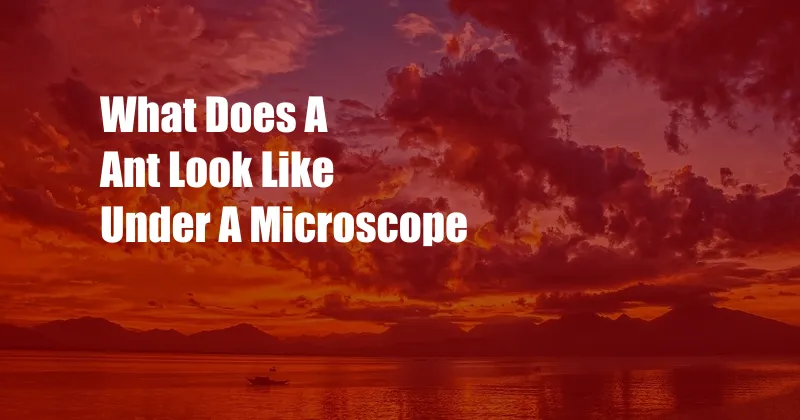
What Does an Ant Look Like Under a Microscope?
Have you ever wondered what an ant looks like under a microscope? These tiny creatures are fascinating to observe, and their intricate anatomy is a testament to the wonders of nature. Peering into the microscopic world of ants can be educational and awe-inspiring, revealing details that are often hidden to the naked eye.
When viewed under a microscope, ants exhibit a remarkable level of complexity and adaptation. Their bodies are covered in tiny hairs, giving them a velvety appearance. Their heads are equipped with large compound eyes, allowing them to see in all directions. The mandibles, or jaws, are sharp and powerful, used for biting and chewing food. The antennae, located on the head, are sensory organs that help ants communicate and navigate their environment.
Unveiling the Microscopic Details
The thorax, the middle section of the ant’s body, is where the legs are attached. Ants have six legs, each with three segments. The legs are covered in tiny claws, enabling them to grip surfaces securely. The abdomen, the rearmost section of the ant’s body, is where the digestive and reproductive organs are located. In some species, the abdomen may have a stinger, which is used for defense.
The internal anatomy of ants is equally fascinating. The digestive system consists of a foregut, midgut, and hindgut. The foregut includes the mouth, esophagus, and crop, where food is stored. The midgut is where most of the digestion takes place, and the hindgut is where waste is eliminated. The circulatory system is open, meaning that blood flows directly throughout the body cavity. The respiratory system consists of a series of air sacs, which help to distribute oxygen throughout the body.
Exploring the Diversity of Ants
Ants come in a wide variety of shapes, sizes, and colors. Some ants are tiny, measuring only a few millimeters in length, while others can grow up to several centimeters. The largest ant species, the giant driver ant, can reach up to 5 centimeters in length. Ants can be black, red, brown, or even metallic green or blue. Some species have wings, while others are wingless. The diversity of ants reflects the wide range of habitats they occupy, from tropical rainforests to deserts.
Ants play an important role in the ecosystem. They are scavengers and help to break down organic matter. They also aerate the soil and disperse seeds. Some ants, such as leafcutter ants, farm fungi for food. Ants are social insects and live in colonies that can range in size from a few dozen to several million individuals. Colonies are organized into a hierarchy, with a queen, workers, and soldiers.
Tips for Observing Ants Under a Microscope
If you are interested in observing ants under a microscope, here are a few tips:
- Collect ants from an outdoor area, such as a garden or park.
- Place the ants in a clear container, such as a petri dish, and cover them with a lid.
- Use a magnifying glass or microscope to examine the ants.
- Be careful not to touch the ants directly, as this can damage them.
Observing ants under a microscope can be a fun and educational experience. It is a great way to learn about the fascinating world of insects and their important role in the ecosystem.
Frequently Asked Questions
- Q: What is the best way to collect ants for observation?
- A: The best way to collect ants for observation is to use a magnifying glass or microscope to find them in an outdoor area, such as a garden or park. Place the ants in a clear container, such as a petri dish, and cover them with a lid.
- Q: How can I tell the difference between a queen ant and a worker ant?
- A: Queen ants are typically larger than worker ants and have a larger abdomen. They also have wings, while worker ants do not.
- Q: What is the function of an ant’s antennae?
- A: Ants’ antennae are sensory organs that they use to communicate and navigate their environment.
Conclusion
Ants are fascinating creatures that play an important role in the ecosystem. Observing ants under a microscope can be a fun and educational experience, providing a glimpse into their intricate anatomy and complex social behavior. Whether you are a curious child or a seasoned scientist, there is something to be learned from the microscopic world of ants.
If you are interested in learning more about ants, there are many resources available online and in libraries. You can also visit a local museum or nature center to learn about ants and other insects.
Are you interested in learning more about the fascinating world of ants?